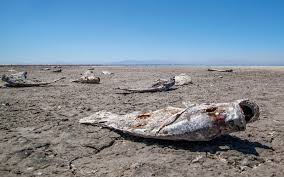Till Sun and Moon Shines [Part 8]
By Eng. Chandana JayawardanaHuman Interference to the Natural Water Cycle
Village tank cascade systems is a prominent landmark in dry Zone, Sri Lanka. In the last column, a general overview of this system was presented. Before considering the factors behind their sustainability, it would be appropriate to discuss couple of examples where man-made irrigation options had negatively affected the human-water interaction and the natural water cycle.
Different forms of water movement and changes of its physical state occur in a natural, recurring consequence known as “The hydrological cycle”. The movement of water in the hydrological cycle extends through the four parts of the total Earth system; atmosphere, hydrosphere, lithosphere, and biosphere, and strongly depends on the local peculiarities of these components. Such peculiarities may be due to natural causes such as lithosphere surface topology or human activities like artificial water utility structures. The places with abundant fresh natural water supply may become arid waste land within short duration, depending on the strategies adopted in water management. Few examples are quoted below to indicate adverse effects of human interference on the water utilization and their short term “rate of returns” on degrading natural ecosystems.
(1) Los Angeles aqueduct project in the United States: With the view of addressing water imbalance prevailed at the Los Angeles city, a 375km long aqueduct with 164 tunnels was constructed from Owen Valley in order to convey water to Los Angeles. The project was completed in 1913, and within short period of time, Owen Valley what had once been a green and fertile land, turned to an arid waste, completely drying up Owen Lake by 1924.

The Los Angeles aqueduct project
(2) Tehri Dam in Uttarakhand, India: 265m high Tehri dam in India formed a reservoir of 75km long, completely submerging the old town of Tehri. Construction of the dam has disrupted the underground sources of the area’s natural springs, leaving residents of more than 100 villages scattered around the reservoir’s rim, to undergo acute water shortage. The villagers can’t obtain water from the reservoir itself as the walls of the reservoir are the exposed sides of a blasted mountain made of loose gravel too steep to climb, and forced to seek for pumped water solutions.

Tehri dam project
(3) Colorado River Diversion in United States: With the view of greening the Colorado Desert, a project was implemented in 1900. This was by diverting Colorado river to Alamo river, then canalize the Alamo and permanently connecting it to the Colorado so just enough water could be taken out for irrigation. By 1905, the project had to be abandoned as the sand filled canals and the silted gates were preventing the water flow as originally designed.

Colorado river diversion project
Unsustainable water utilization in above instances is not due to any alteration of physical or chemical properties of water. If those are the causes, legal and technical measures concerning environmental protection might be imposed to mitigate the adversity. But in all these projects, the un-sustainability is solely due to the water management options adopted, which is considered as analogues to commodity flow from producer to consumer. Commodity flow is based on the activities extracting, producing, consuming, and decomposing. In instances discussed above, natural source of water is tapped (extracting), infrastructure developed for conveyance (producing), water thus conveyed is used for human activities (consuming) and finally drained to a drainage stream (decomposing). This type of process is an open system, with broken cycles as point of consuming is far remote to the point of extraction. Geographic dissipation thus created removes water from its natural locality. The result would be the water shortages at the point of extraction, finally making the entire ecosystem unstable.
Operation of natural hydrology cycle itself will not ensure the water availability, but the water utilization strategy also should be structured in cyclic manner. Time as well as space parameters are important in this respect as water extracted from a point should be returned within reasonable time and reasonably closer to that point, hydrologically enriching the vicinity. Apart from the water, all forms of materials associated with water utilization should follow the same principle. This type of cyclic operation is well evident in the ancient water management strategies adopted in small tank cascade systems.
 Eng. Chandana Jayawardana has earned his first degree in Electrical Engineering from University of Moratuwa and then, post graduate qualifications in Industrial Engineering and Buddhist Studies. He is currently working as Design Manager, Balfour Beatty Ceylon (Pvt) Ltd, Katunayake.
Eng. Chandana Jayawardana has earned his first degree in Electrical Engineering from University of Moratuwa and then, post graduate qualifications in Industrial Engineering and Buddhist Studies. He is currently working as Design Manager, Balfour Beatty Ceylon (Pvt) Ltd, Katunayake.





